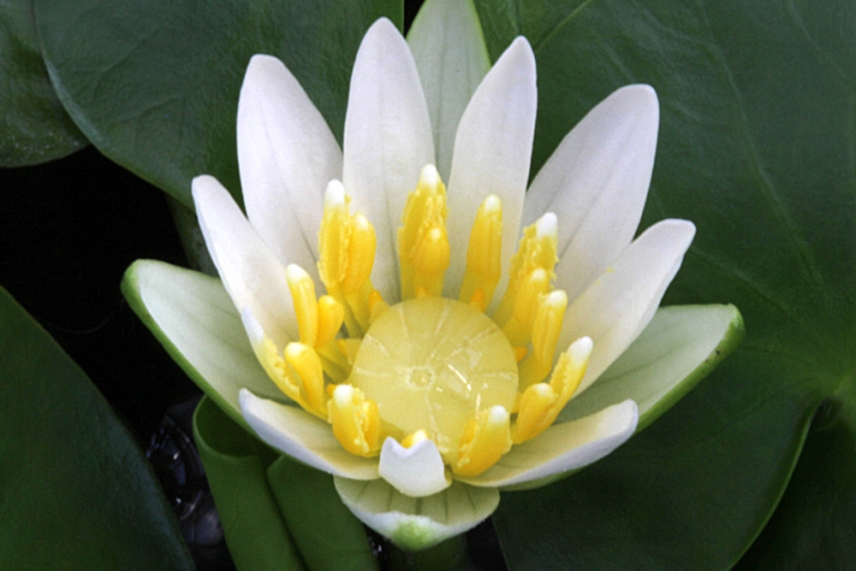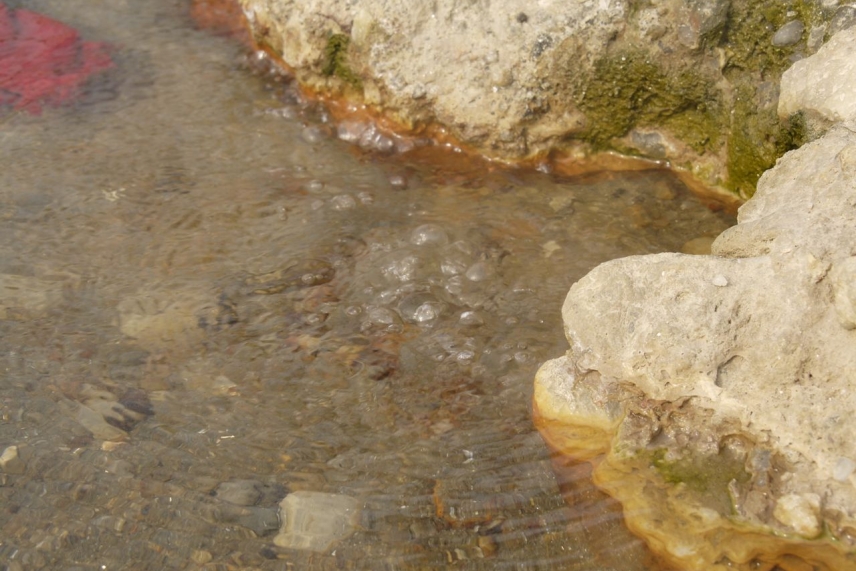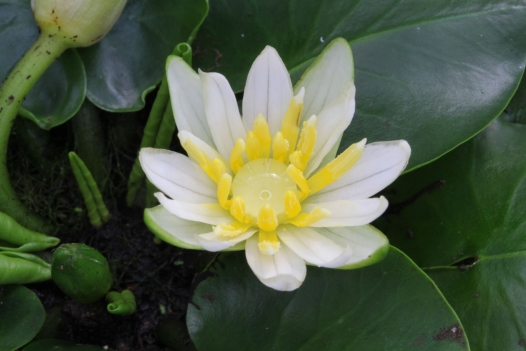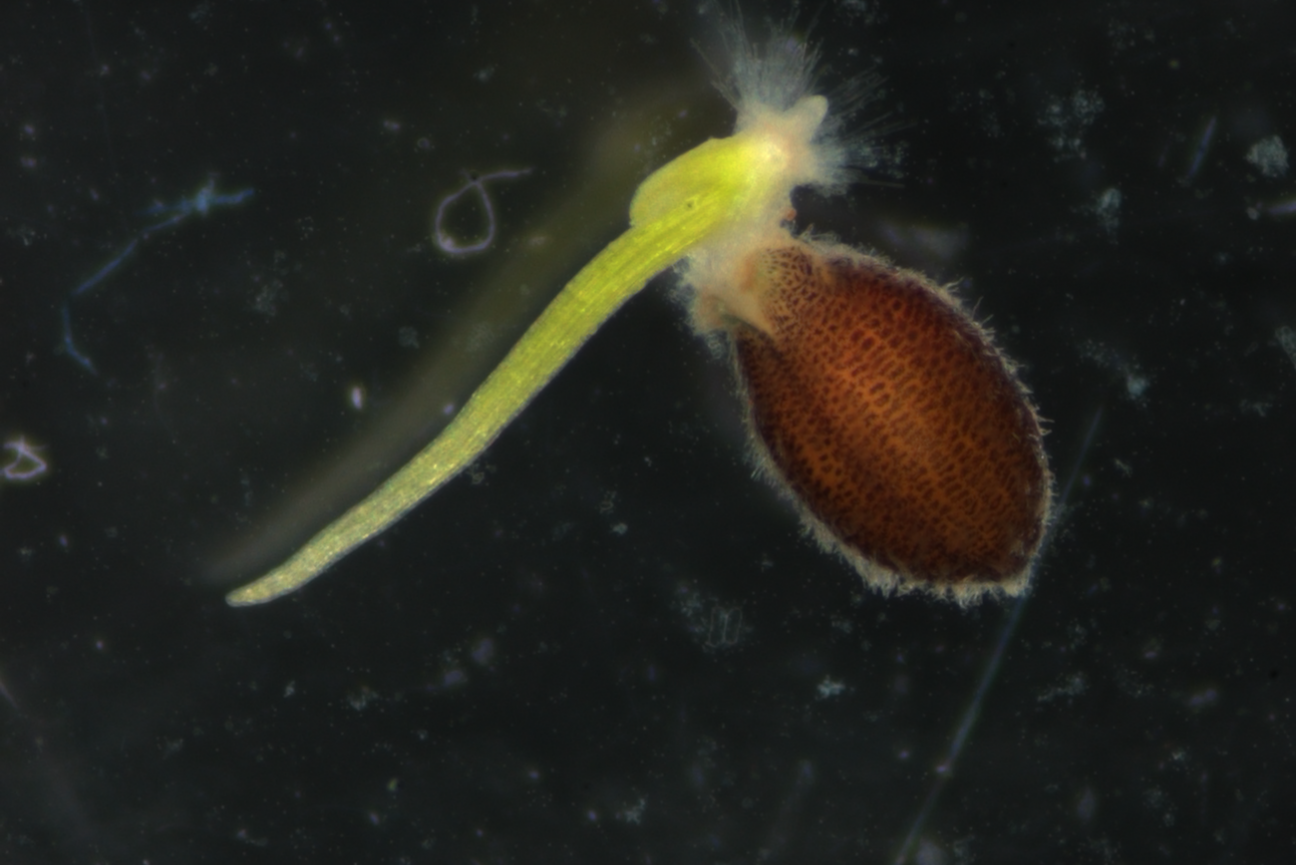Unusual Labmates: The world's smallest water lily
Unusual Labmates is a series that will explore some of the uncommon species used for research at Whitehead Institute. From rare plants to luminescent beetles to regenerative starfish and worms, these organisms and their unusual traits provide insights into the underlying biology and incredible diversity of living things.
The world's smallest water lily

Rebecca Povilus
This story is part of our series on some of the uncommon species used for research at Whitehead Institute, Unusual Labmates. Click here to see all stories in this collection.
Nymphaea thermarum is a tiny waterlily with big potential as a research tool. Rebecca Povilus, a postdoctoral researcher in Whitehead Member Mary Gehring’s lab, is using the waterlily — thought to be the world’s smallest — to learn about the evolution of flowering plants. The fact that this research can happen is quite remarkable, because N. thermarum went extinct in the wild around 2009.

Rebecca Povilus
Much of N. thermarum’s value as a research subject has to do with its place in evolutionary history. This water lily is part of a group of species that split off from other flowering plants early on; their most recent common ancestor with other flowering plants is near the start of the flowering plants’ evolutionary tree. Studying such groups is important because they provide a unique perspective on the evolution of traits that define the flowering plants.
Researchers compare traits in distantly related plants to understand how and when these traits have evolved and changed. By including information from an early-diverging lineage such as the water lilies, researchers can begin to piece together what traits flowering plants may have had during the earliest phases of their history. The more complete researchers’ understanding of the evolutionary history and diversity of flowering plants, the better able they are to pinpoint essential biological processes and identify the genes that control these.
In spite of water lilies’ rich potential as a source of scientific knowledge, researchers did not consider them promising experimental candidates due to their big size, slow generational turnover, and large genomes. N. thermarum is the first known member of this ancient lineage that is easy to grow and study in the lab. Identifying the species as a research tool opened up new possibilities in flowering plant research — but the species almost went extinct before this could happen.

“Heetwater bronnen” by Martijn.Munneke under CC-BY-2.0
A German botanist, Dr. Eberhard Fischer, discovered the water lilies growing around the edges of a hot spring in Rwanda in 1987. The flowers were named in honor of their location: thermarum, from a thermal spring.
Fischer searched for the lilies in other locations, but could not find them anywhere else. The tiny habitat surrounding one hot spring was the lilies’ only home, and when the spring water was diverted for agricultural purposes, the land dried up and the flowers died. If Fischer had not collected samples of the rare flower, the plant would have vanished from existence, taking its biological secrets with it.

N. thermarum specimens in the Whitehead Institute greenhouse
Rebecca Povilus
Instead, the surviving specimens lived on in curated collections, first at the Bonn Botanical Garden in Germany and then Kew Gardens in England. However, botanists hoping to save the plants hit a snag; when they attempted to grow new lilies from seeds, the plants refused to flower. It seemed that N. thermarum might be doomed after all.
Determined to save the species, Kew horticulturist Carlos Magdelena began systematically testing different growing environments for the lilies. Eventually, using notes about the species’ natural habitat, he deduced the unusual conditions they required in order to flower. Whereas most waterlilies flower while submerged in deep water, N. thermarum prefers to be in shallow water or mud, like the edges of a hot spring. When planted in those conditions, the plants thrived, and Kew soon built a large collection.

Rebecca Povilus
Povilus came across N. thermarum when searching for a waterlily that was tiny and had a quick lifecycle. These traits were necessary for a good research tool, because Povilus needed to plant many specimens in a small space and observe changes over their generations in a short time period. N. thermarum flowers are only a few centimeters wide, and plants produce flowers throughout the year. The species also has a relatively small genome, simplifying the task of cataloguing its genes. Povilus realized she had found her ideal plant.
Povilus reached out to the Bonn and was given seeds to start her collection — first at the Arnold Arboretum in Boston and now at Whitehead Institute. She is using N. thermarum to research the evolution of reproductive traits in flowering plants. The diminutive lily has fascinating reproductive behavior, starting with how it flowers.

The female N. thermarum flower
Rebecca Povilus
The male N. thermarum flower
Rebecca Povilus
Water lilies, including N. thermarum, switch between visually distinct female and male phases. On the first day a water lily flower opens, it acts as a female. The flower secretes a droplet in its center, covering its stigma (the receptive part of the flower’s female reproductive organ). When insects land on the flower, pollen that they carry gets trapped in the droplet and sinks onto the stigma, eventually leading to fertilization. At night, the flower closes up. The droplet disappears, and in the morning when the flower unfurls its petals, it will be in its male phase. The stamens, the male reproductive organs, mature during the next days and release their pollen.
However, the divide between the flower’s phases is imperfect in N. thermarum: a small amount of pollen is produced and released onto the stigma before the flower ever opens. This causes the plants to frequently self-fertilize, as the first pollen they are exposed to in their female phase is their own. Although self-fertilization can be advantageous in situations where pollinators are sparse, many plants avoid it in order to foster genetic variation. Indeed, the ability for a flower to self-fertilize is rare even among other water lilies. N. thermarum’s predisposition towards self-fertilization may have negatively impacted its survival in the wild.

In this N. thermarum seed, the embryo is the innermost brown section, surrounded by the endosperm, also in brown. The yellow bulk of the seed is nutrient storage.
Rebecca Povilus
The primary goal of Povilus’ current investigations in N. thermarum is to learn more about a defining feature of flowering plants, the endosperm. Endosperm is a tissue unique to flowering plants that acts much like a mammalian placenta, mediating nutrient supply from the mother plant to the embryo inside the seed. Endosperm tends to be filled with starch and other nutrients and is in fact the cornerstone of our global food supply: rice, corn, wheat and other cereal grains primarily consist of endosperm. Due to its agricultural and biological significance, researchers are eager to learn more about endosperm’s origin and the molecular processes that control its development.
N. thermarum seeds are unusual in that the bulk of their nutrients are stored in tissue outside of the endosperm and filtered through it, rather than being stored in the endosperm itself. However, the endosperm is still where nutrient dynamics between the maternal plant and the embryo play out.

A microscope image of an N. thermarum young embryo and endosperm (black) growing inside a seed
Rebecca Povilus
The nutritional value provided by a maternal plant to its seeds is thought to differ in part due to competing interests of the maternal and paternal plant. Each maternal plant contains seeds fertilized by the pollen of different paternal plants. The parental conflict theory states that it’s in the interests of the maternal plant to give each of its seeds an equal amount of nutrients, but it’s in the interest of the paternal plant that its seed gets more nutrients than the others. This conflict plays out in the endosperm via a process called genetic imprinting.
A seed receives copies of each gene from both its mother and its father. Genetic imprinting silences the gene received from one of the parents so that only the other parent’s copy is expressed. This differential expression allows the genes from one parent to promote the type of nutrient demand and seed development in their best interest. Therefore the course of the seed’s development is partially determined by the balance of maternally and paternally expressed genes.
Imprinted genes are known to control endosperm and seed development in distantly related plant species, suggesting that imprinting has been important since the very origin of endosperm and flowering plants. However, patterns of gene imprinting and the processes that regulate them appear to be different for different groups of plants. By studying gene imprinting in N. thermarum, Povilus aims to shed light on how this diversity evolved. Importantly, insight from N. thermarum will help identify the core components of the processes involved in gene imprinting during seed development. This information could then be used to develop tools for plant breeding or for improving nutrient content in seed crops.

An N. thermarum seed begins to sprout
Rebecca Povilus
The knowledge gleaned from N. thermarum could help researchers understand fundamental biological processes. Yet the opportunity to investigate the species was almost lost when its natural habitat was destroyed. There is a strong relationship between basic research and biodiversity, Povilus says. Protecting more species means keeping potential avenues of scientific investigation open, and scientific investigation can be a driving force in preserving a disappearing species. In recent years, Povilus and other researchers studying N. thermarum have been distributing seeds to labs that ask for them in the hopes that the species could become a mainstay of plant research. Because of these scientific exchanges, the tiny water lily lives on not only at Whitehead Institute, but in a growing number of labs and botanical gardens around the world — and one day it may grow again on the banks of hot springs in Rwanda.
Written by Greta Friar
Water lily images by Rebecca Povilus
Special thanks to Rebecca Povilus and Mary Gehring
References:
Fischer, Eberhard & Magdalena Rodriguez, Carlos. (2010). 690. NYMPHAEA THERMARUM. Curtis’s Botanical Magazine. 27. 318 - 327. 10.1111/j.1467-8748.2010.01711.x.
Povilus RA, Losada JM, Friedman WE. (2015). Floral biology and ovule and seed ontogeny of Nymphaea thermarum, a water lily at the brink of extinction with potential as a model system for basal angiosperms. Ann Bot 115:211–226. 10.1093/aob/mcu235.
Contact
Communications and Public Affairs
Phone: 617-452-4630
Email: newsroom@wi.mit.edu

